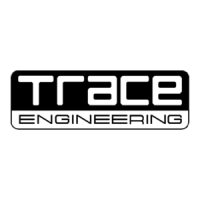©1999 Trace Engineering
Pre-Installation
Before installing the power panel, read all instructions and cautionary markings located in this
manual.
NOTE: The power panel is quite heavy (weighing up to 400 pounds depending upon configuration).
Always use proper lifting techniques during installation to prevent personal injury.
Mounting: The power panel should be mounted indoors in a clean, dry environment. If the panel must be
installed in close proximity to the batteries, make sure the area is adequately ventilated to the outside.
Tools required:
#2 Phillips screw driver Level
1/4" Slotted screw driver Wire strippers
1/2" open-end wrench Torque wrench
Socket wrench and fittings Electrical Tape
Multimeter Pencil
Hole saw Utility knife
Hardware / Materials required:
4' x 8' sheet of 3/4" plywood
#12 wood screws (or 3/4" x 1-1/4" lag bolts)
#10 wood screws
1/4" x 3" lag bolts
Conduit and appropriate fittings
Wire nuts (if allowed by code)
Wiring:
All wiring and installation methods should conform to applicable electrical and building codes.
Pre-plan the wire and conduit runs. The ac terminal blocks accept up to a #6 AWG wire; the dc circuit
battery disconnects accept cable sizes up to #4/0 AWG. Use #4/0 AWG for a 250 amp dc disconnect and #2/0
AWG for a 175 amp dc disconnect.
For maximum safety, run both ac and dc wires/cables in (separate) conduits.
AC Connections:
Use #6 AWG THHN wire for all ac wiring.
DC Connections:
Battery to inverter cabling should be only as long as required. If #4/0 AWG cables are used for example,
do not exceed 5 feet (one way) in 12 V dc systems; 10 feet (one way) in 24 V dc systems; or, 15 feet (one
way) for 48 V dc systems. For optimum performance, use pre-assembled battery cables from Trace,
designed specifically for this application.
Grounding:
AC Grounding
The power panel should be connected to a grounded, permanent wiring system. Neutral and Ground
conductors should only be bonded at the main service panel.
DC Grounding
The negative battery conductor should be bonded to the grounding system at only one point in the
system. The size for the conductor is usually based on the size of the largest conductor in the dc system.
2
2.0 INSTALLATION

